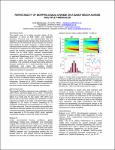REPEATABILITY OF MORPHOLOGICAL CHANGE ON A SANDY BEACH ACROSS MULTIPLE TIMESCALES
| dc.contributor.author | Blenkinsopp, C | |
| dc.contributor.author | Bayle, P | |
| dc.contributor.author | Baldock, T | |
| dc.contributor.author | Conley, D | |
| dc.contributor.author | Masselink, G | |
| dc.date.accessioned | 2024-03-01T10:08:55Z | |
| dc.date.issued | 2023-09-01 | |
| dc.identifier.isbn | 9780989661164 | |
| dc.identifier.issn | 0589-087X | |
| dc.identifier.issn | 2156-1028 | |
| dc.identifier.uri | https://pearl.plymouth.ac.uk/handle/10026.1/22114 | |
| dc.description.abstract |
<jats:p>The swash zone is a highly dynamic region of the nearshore in terms of both hydro- and sediment dynamics. Previous work has demonstrated that the majority of swash events transport only small amounts of sediment and net beachface volume change over several hours tends to be small. However, a small number of individual swash events can deposit or remove hundreds of kilograms of sediment per metre width of beach. These events are typically associated with swash flows that involve one or more highly turbulent swash-swash interactions, causing enhanced suspension and transport of sediment (Blenkinsopp et al. 2011). The timing and location of these interactions is complex and small changes in either can lead to very different local flow conditions. The complexity of these flows make sediment transport prediction on a swash-by-swash basis very challenging, and raises the question whether deterministic physical and numerical modelling of swash sediment transport is warranted. </jats:p> | |
| dc.format.extent | 1-1 | |
| dc.publisher | Coastal Engineering Research Council | |
| dc.subject | 37 Earth Sciences | |
| dc.subject | 3705 Geology | |
| dc.title | REPEATABILITY OF MORPHOLOGICAL CHANGE ON A SANDY BEACH ACROSS MULTIPLE TIMESCALES | |
| dc.type | conference | |
| dc.type | Conference Proceeding | |
| plymouth.issue | 37 | |
| plymouth.publisher-url | http://dx.doi.org/10.9753/icce.v37.sediment.1 | |
| plymouth.conference-name | 37th International Conference on Coastal Engineering, ICCE 2022 - Sydney, Australia | |
| plymouth.publication-status | Published online | |
| plymouth.journal | Coastal Engineering Proceedings | |
| dc.identifier.doi | 10.9753/icce.v37.sediment.1 | |
| plymouth.organisational-group | |Plymouth | |
| plymouth.organisational-group | |Plymouth|Research Groups | |
| plymouth.organisational-group | |Plymouth|PRIMaRE Publications | |
| plymouth.organisational-group | |Plymouth|Faculty of Science and Engineering | |
| plymouth.organisational-group | |Plymouth|Faculty of Science and Engineering|School of Biological and Marine Sciences | |
| plymouth.organisational-group | |Plymouth|Research Groups|Marine Institute | |
| plymouth.organisational-group | |Plymouth|REF 2021 Researchers by UoA | |
| plymouth.organisational-group | |Plymouth|Users by role | |
| plymouth.organisational-group | |Plymouth|Users by role|Academics | |
| plymouth.organisational-group | |Plymouth|REF 2021 Researchers by UoA|UoA07 Earth Systems and Environmental Sciences | |
| plymouth.organisational-group | |Plymouth|Users by role|Researchers in ResearchFish submission | |
| plymouth.organisational-group | |Plymouth|REF 2029 Researchers by UoA | |
| plymouth.organisational-group | |Plymouth|REF 2029 Researchers by UoA|UoA07 Earth Systems and Environmental Sciences | |
| dcterms.dateAccepted | 2023-01-01 | |
| dc.date.updated | 2024-03-01T10:08:54Z | |
| dc.rights.embargodate | 2024-3-2 | |
| dc.identifier.eissn | 2156-1028 | |
| rioxxterms.versionofrecord | 10.9753/icce.v37.sediment.1 |


